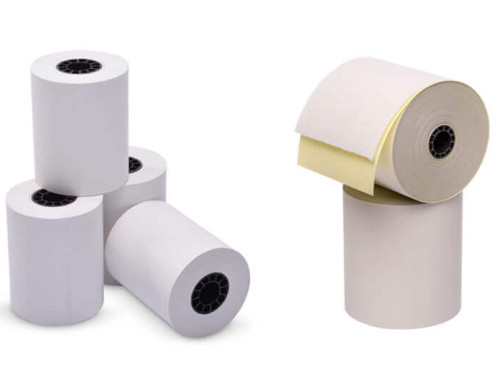Printing is one of the most important and everyday tasks undertaken by an organization on a day-to-day basis. One of the most common types of printing among modern-day businesses is receipt printing. This is especially the case for retail, dining, hospitality, and other businesses where POS (Point of Sale) systems are commonly used.
However, traditional receipt printing with ink printers is often a tedious task for most business owners and requires additional effort. For this reason, thermal paper receipts are becoming more and more popular.
In this blog, we will be thoroughly discussing the concept of thermal paper, its composition, benefits, uses, and more. Read this blog till the very end to get complete information on the subject.
Let’s start by discussing the concept of thermal paper in detail.
What is Thermal Paper?
When printing receipts, there are usually two approaches: conventional printing and thermal printing.
Conventional printing is a commonly known concept across the globe. Here, the receipts are printed on regular paper using printing ink. However, this involves numerous challenges like regularly upkeeping the printers, changing their cartilages, etc.
Owing to this reason, thermal printing is becoming more and more popular. Thermal printing involves using heat to print on a special type of paper, which is known as thermal paper. You can find thermal paper rolls in various sizes and price ranges. All of these sizes are made to serve different types of printing purposes.
This paper is different from the regular paper in many ways. Numerous chemicals and compounds go into its production. We will be taking a look at these compounds and understanding the composition of thermal paper in the coming section.
What are Thermal Papers Made of?
As we mentioned earlier, a lot of chemicals and compounds go into the process of making this special type of paper that is used for thermal printing. Let’s take a look at each compound one by one.
1. Base Paper
The process of making thermal paper starts from ordinary paper (offset paper). This base paper, like any other regular paper, is made from wood pulp. Numerous compounds are then layered on this paper to make it suitable for thermal printing.
2. Pre-coat
A layer of pre-coat is applied on the regular paper to enhance its heat retention capability. Not just that, pre-coat also makes the final paper smooth and durable, therefore adding to its quality.
3. Thermal Coat
This is the most important part of making thermal paper. Here, the thermal coat comprises more than a dozen chemical compounds that react to the heat to produce prints. Leuco dyes, developers, and sensitizers are the primary resources in thermal coat to generate what we see as a print.
- Leuco dyes and developers: Leuco dyes are made up of colorless crystals ground into a fine powder. The heat produced by a thermal print head melts the dye crystals wherever they touch, which then mixes with the developer – an organic acid also present in the coating to create an opaque color. The most commonly used developers are Bisphenol-A (BPA) or Bisphenol-S (BPS).
- Sensitizers: It is important to ensure that the thermal reaction takes place at the right temperature. For this reason, sensitizers are added to thermal paper. These sensitizers maintain the temperature at which the thermal reaction will be triggered in the paper.
Now that you know what exactly goes into the process of creating papers for thermal printing, let’s go ahead and understand how thermal paper exactly works.
How Does Thermal Paper Work?
In the previous section, we discussed the mechanism of thermal papers. Do note that there are mainly two ways to print with the thermal printing technique- direct thermal printing and thermal transfer printing.
1. Direct Thermal Printing
This is the most commonly adopted style of thermal printing. Here, a heated printhead is directly placed over the thermal paper. Upon contact with the heated printhead, the thermal ink in the paper gets activated. What we see then is an image or a text generated from this ink.
2. Thermal Transfer Printing
Another way to print material on a thermal paper roll is to use a wax-coated ribbon. Here, the printhead, instead of pressing the heated printhead directly on the paper, is pressed on an ink ribbon that is coated with wax.
This type of thermal printing produces high-quality prints and can even be used to print material in multiple colors. Additionally, the prints created from thermal transfer printing are usually highly durable and less likely to fade over time.
Now that you know about different ways of thermal printing, it is time to discuss ‘how exactly is thermal paper better ?’ The coming section will shed light on this topic.
Advantages of Using Thermal Paper
So far, we have briefly discussed how using thermal paper for receipt printing is better than using conventional printing techniques. Let us tell you that there’s more to thermal paper than just convenience. Let’s take a look at these benefits in detail.
1. Low Cost
Conventional receipt printing requires the use of ink. As a result, businesses need to spend additionally on ink cartridges. However, thermal printing is an inkless technique for printing receipts. Since the printing takes place through heat, there isn’t any ink used in the printing process.
This way, using thermal paper for printing your receipts can help you save a lot of money in the long run, directly contributing to the cost efficiency of your organization.
2. Faster Printing
Optimal operational efficiency and speed are important for a business. This is especially the case for businesses operating in the dining and hospitality industry. This is because, for such businesses, lagging in operational efficiency can directly hinder their customer experience.
Shifting from conventional to thermal receipt printing can help you reduce the print time to milliseconds. This faster printing speed enabled by thermal paper allows businesses to use thermal printing not only for creating receipts but also for package printing, label printing, and more.
3. Durable
Conventional ink printers have complex mechanisms that are likely to wear out in a short time. If you use these printers for a heavy workload, your printer is likely to go obsolete quickly. Moreover, conventional printed s often demand periodic maintenance.
Thermal printers, on the other hand, have comparatively fewer moving parts as compared to conventional printers. You can use these printers with thermal paper to create high-quality prints without worrying about wearing off the printer. These printers can handle heavy workloads and are not prone to jamming, breaking down, and other shortcomings of ink printers.
4. High Quality
Optimal print quality is an important factor when choosing a printing technique. This is especially the case for businesses and organizations that print thousands of materials on an everyday basis. This includes not only receipts but also other business materials like labels, tickets, etc.
Ink printers, when used for heavy-duty printing, can cause ink smudges and smears across the paper. Catching these smudges and correcting them can be a time-consuming process in itself. Thermal paper, on the other hand, always yields high quality and generates precise prints with no smears. Since the thermal reaction takes place only in the area where heat is applied, there are no chances of faulty printing.
Summing It Up
Thermal paper is an excellent and modernistic printing medium at present. This material outshines traditional ink printing in numerous aspects and is becoming the go-to choice of businesses. Today, thermal papers are used for printing a wide variety of materials like receipts, labels, packaging, and more. By now, we are sure you know how to use thermal paper, its advantages, composition, and more. Now, you are ready to start using thermal paper rolls for your business and can safely shift from ink printing to thermal printing.
Looking for High-quality Thermal Paper?
Panda Paper Roll is a globally leading thermal paper roll manufacturer. We offer high-quality and cost-effective thermal paper rolls to businesses and organizations. We have all sizes of thermal paper rolls to help you fulfill your business requirements with ease. Get in touch with us today to learn more about thermal paper or to buy our products.







hey there i would like to know more about your company products.
and also how can i be agent for the products you provide,